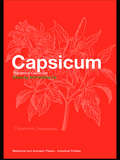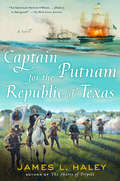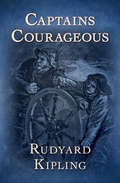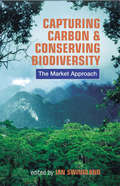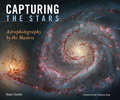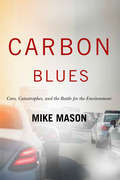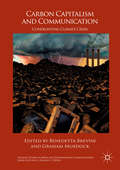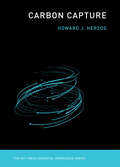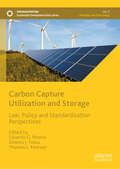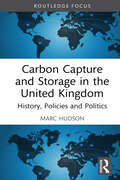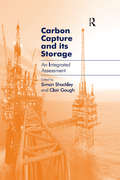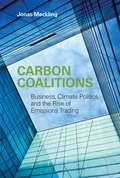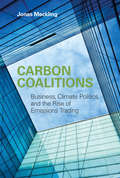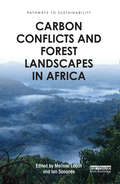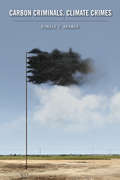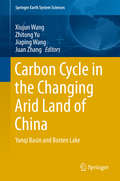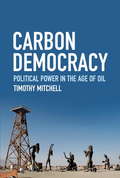- Table View
- List View
Capsicum: The genus Capsicum (Medicinal And Aromatic Plants Industrial Profiles #33)
by Amit Krishna DeCapsicum has been used since ancient times not only as a traditional medicine but also as a natural colorant. The medicinal properties of capsicum make it popular in both ayurvedic and homeopathic treatments.
Captain Alatriste: A swashbuckling tale of action and adventure (The Adventures of Captain Alatriste)
by Arturo Perez-ReverteA thrilling,swashbuckling adventure series starring the Spanish D'ArtagnanCaptain Alatriste is a swordsman for hire in Spain at a timewhen Court intrigue is high and the decadent young king has dragged the countryinto a series of disastrous wars. As a hired blade, Alatriste becomes involvedin many political plots and must live by his wits. He comes face to face withhired assassins, court players, political moles, smugglers, pirates and ofcourse, the infamous Spanish Inquisition...Introducing Iñigo Balboa, Alatriste's young page; Quevedo, asubversive poet who likes to start fights in the local tavern, the elegantCount of Guadalmedina, and the beautiful but deadly Angelica de Alquezar,CAPTAIN ALATRISTE is a thrilling tale of adventure and intrigue that will appealto anyone who enjoyed The Three Musketeers.
Captain Putnam for the Republic of Texas (A Bliven Putnam Naval Adventure #4)
by James HaleyCaptain Bliven Putnam returns in an exhilarating new adventure, embedding himself within a top-secret mission during the Texas Revolution that puts everything at risk.Having spent the past few years on missions in the Caribbean, Captain Bliven Putnam is all but ready to retire and settle down at home in Connecticut with his wife, Clarity. But as the Texas Revolution ignites and tensions in the Gulf of Mexico rise, Putnam is sent orders for a secret cruise that could decide the fate of their rebellion. American settlers in Texas have revolted against an increasingly tyrannical Mexican government. While the Texians have a small army under the command of Sam Houston, their navy is practically nonexistent, an insurmountable and dangerous disadvantage as the Mexican invasion is supplied by sea. Unable to risk American neutrality, United States President Andrew Jackson hand-selects Putnam to lead a secret mission that might turn the tide: In Putnam's aging sloop-of-war Rappahannock, disguised with the Republic of Texas flag, he must venture into the waters of the Gulf and intercept the Mexican armaments, not just fighting the Mexican Navy but incurring the wrath of the American shippers and insurance companies who favor Mexico. Reunited with his old friend Sam Bandy, Putnam teams up with Sam Houston to run the operation, all while the bloodiest battles of the Revolution rage.
Captains Courageous: A Story Of The Grand Banks
by Rudyard KiplingThis dramatic nineteenth-century nautical adventure and classic coming-of-age story is one of Rudyard Kipling&’s most enduringly popular works. Harvey Cheyne Jr., the teenage son of a millionaire American railroad tycoon, is sailing to Europe on a luxury liner when he falls overboard off the coast of Newfoundland. He&’s saved from drowning by the We&’re Here, a New England fishing schooner captained by Disko Troop. He&’s alive, but his tough new companions find him to be spoiled and ignorant. Desperate to get back to the world he knows, Harvey must prove his worth as one of the crew by mastering the challenging tasks and physical labor of life at sea. With help from the captain&’s son, Dan, he braves a number of risky exploits and adventures as they travel along the Grand Banks of Newfoundland. Shedding his expectations of a pampered life, Harvey begins to embrace the tough work of a fisherman. Filled with thrilling action, this classic sea story will delight and excite readers of all ages.
Capturing Carbon and Conserving Biodiversity: The Market Approach
by Ian R. SwinglandFor decades conservation has been based on the donor-driven principle. It hasn't worked. For centuries, environmental pollution or degradation has been addressed by the same attitude: the 'Polluter Pays' principle. That hasn't worked either. The cycle has to stop. But while everyone talks about using a market-driven approach, few know how to do it. Faced with the situation on the ground what do you do? What is happening? How can you engage a system so that it is self-sustaining and the people self-motivated? This study explores how the growing market in carbon can help to conserve carbon-based life forms. It discusses how reducing global warming and saving biodiversity can both be achieved with the right market conditions. The contributors include conservation biologists, ecologists, biologists, economists, lawyers, community and tribal specialists, financial specialists, market makers, environment specialists, climatologists, resource managers, atmospheric scientists, project developers and corporate fund managers.
Capturing the Stars: Astrophotography by the Masters
by Robert GendlerPortraits of the deep sky and of local astronomical phenomena taken by the world&’s renowned astrophotographers—with a foreword by Neil deGrasse Tyson. To gaze at the stars is one thing; to capture that gaze in photographs is something else, a tantalizing scientific art that many attempt and few master. That rare mastery is on full display in this beautiful volume of space photography from thirty of the most accomplished astrophotographers in the world, both professional and amateur. Galaxies, star clusters, nebulae, and other deep-sky treasures fill the pages. Along with the marvels of the night sky—the Andromeda and Whirlpool galaxies, the Pleiades and the Praesepe, the Orion and Crab nebulae, and many more—each section features a profile of the photographer&’s work, techniques, philosophy, and experiences. Compiled by the world&’s leading amateur astrophotographer, with an introduction to the history of space photography, this spectacular volume is an essential for every stargazer&’s bookshelf.elf.
Capybara: Biology, Use and Conservation of an Exceptional Neotropical Species
by Emilio A. Herrera David W. Macdonald José Roberto Moreira Katia Maria FerrazThe capybara is the neotropical mammal with the highest potential for production and domestication. Amongst the favorable characteristics for domestication we can list its high prolificacy, rapid growth rate, a herbivorous diet, social behavior and relative tameness. The genus (with only two species) is found from the Panama Canal to the north of Argentina on the east of the Andes. Chile is the only country in South America where the capybara is not found. The species is eaten all over its range, especially by poor, rural and traditional communities engaged in subsistence hunting. On the other hand, in large urban settlements wildlife is consumed by city dwellers as a delicacy. The sustainable management of capybara in the wild has been adopted by some South American countries, while others have encouraged capybara rearing in captivity.
Capybaras (Animals)
by Martha E. RustadCapybaras are the biggest rodents in the world! These social animals live in large groups and spend lots of time in water. Get all the facts on these huge rodents.
Car-Free Los Angeles and Southern California
by Nathan LandauThe time has come for Car-Free Los Angeles and Southern California. The peril of global climate change dominates the headlines. In California almost 40% of greenhouse gases come from transportation. More and more people-especially young people-are realizing the current approach to mobility is not sustainable.Car-Free Los Angeles and Southern California is designed as a complete guide to a car-free vacation in Southern California, from the time travelers land or arrive until the time they leave. Car-Free Los Angeles and Southern California reveals how to get from the airport-or the train station or bus station-into town. For Los Angeles or Southern California residents, this book tells how to plug into the transit network and start traveling car-free to the local attractions.Contrary to old stereotypes, Southern California is a great place to travel car-free. It has a lovely train that travels along the coast. It has a ferry across the water to a town with a limit on the number of cars--Avalon on Catalina Island. There's a beautiful city that gives you discounts for traveling car-free. Los Angeles' buses go to the front door of world class museums, theatres, and shops. Disneyland will shuttle travelers from motels to the park.The book lists good places to stay that are transit accessible. Car-Free Los Angeles and Southern California discloses the terrific things to see and do in Southern California with detailed information on how to get there. Whether it's sightseeing, shopping, eating, visiting museums or something else altogether-Car-Free Los Angeles and Southern California will get you there.
Caravans: Lives on Wheels in Contemporary Europe
by Hege Høyer LeivestadIn Caravans, Hege Høyer Leivestad opens the caravan door to understand how daily life is organised among Britons and Swedes who have relocated, either seasonally or permanently, to mobile homes. Leivestad investigates how the caravan and campsite come to fit and challenge conventional domestic ideals, and how the static mobile caravan can nurture ideas of freedom even when it is standing still. With sensitivity and an awareness of the humour and pathos of the lives of her subjects, Leivestad closely examines the shaping of the European camping phenomenon and its day-to-day pleasures and pains, ranging from friendships ties to conflictive bingo nights, from nosy and noisy neighbours to fake fireplaces and rotten awning floors. As the first ethnographic study of caravan life in Europe, Caravans offers a refreshing take on contemporary mobility debates, showing how movement can best be understood by taking a detailed look at certain specific mundanities in material culture. This rich and topical ethnography is a must-read for students of anthropology, human geography and architecture, and for those with an interest in the possibilities and perils of a life on wheels.
Carbon Blues: Cars Catastrophes and the Battle for the Environment
by Mike MasonClimate change is the most serious crisis of our time. As history is being written in fire in California and Greece, in the warming waters of the Gulf of Mexico, and in the melting ice of the Arctic and Antarctica, Carbon Blues demystifies current debates on climate change, discussing everything from carbon dioxide increases in the atmosphere caused by cars, coal, and oil to global warming and worsening natural disasters. A detailed examination of the history of climate change and its present and future consequences, Carbon Blues traces the essential economic importance of coal in the nineteenth century and oil in the twentieth, emphasizing the role of the automobile and the internal combustion engine in the dereliction of our planet. Exposing campaigns to mislead the public, Mike Mason reveals that the fatal consequences of CO2 and NO2 have been widely known for decades but successfully discounted and manipulated by the carbon lobby led by Exxon, BP, figures such as the Koch brothers, and democratically elected governments. The book underlines the disturbing truth: that despite current attempts to remediate climate change, the harm already done - melting polar ice and the warming and rising of the seas - will be virtually irreversible. As the fight against climate change comes to a head, Carbon Blues searches for fruitful ways forward.
Carbon Blues: Cars Catastrophes and the Battle for the Environment
by Mike MasonClimate change is the most serious crisis of our time. As history is being written in fire in California and Greece, in the warming waters of the Gulf of Mexico, and in the melting ice of the Arctic and Antarctica, Carbon Blues demystifies current debates on climate change, discussing everything from carbon dioxide increases in the atmosphere caused by cars, coal, and oil to global warming and worsening natural disasters. A detailed examination of the history of climate change and its present and future consequences, Carbon Blues traces the essential economic importance of coal in the nineteenth century and oil in the twentieth, emphasizing the role of the automobile and the internal combustion engine in the dereliction of our planet. Exposing campaigns to mislead the public, Mike Mason reveals that the fatal consequences of CO2 and NO2 have been widely known for decades but successfully discounted and manipulated by the carbon lobby led by Exxon, BP, figures such as the Koch brothers, and democratically elected governments. The book underlines the disturbing truth: that despite current attempts to remediate climate change, the harm already done - melting polar ice and the warming and rising of the seas - will be virtually irreversible. As the fight against climate change comes to a head, Carbon Blues searches for fruitful ways forward.
Carbon Capitalism and Communication: Confronting Climate Crisis (Palgrave Studies In Media And Environmental Communication)
by Graham Murdock Benedetta BreviniThis volume examines the role of communication in contributing to and contesting the current climate crisis. There is now widespread agreement that even if increases in carbon emissions are kept to the current international target the climate crisis will continue to intensify. This book brings together, for the first time, state-of-the-art research with activists' interventions to place debate around climate crisis within the wider conversation about the changing relations between communications and contemporary capitalism. Contributors include; Naomi Klein, Michael Mann, Alan Rusbridger, Vincent Mosco, Jodi Dean, and leading figures in Greenpeace and 350. org.
Carbon Capture (The MIT Press Essential Knowledge series)
by Howard J. HerzogA concise overview of carbon dioxide capture and storage (CCS), a promising but overlooked climate change mitigation pathway.The burning of fossil fuels releases carbon dioxide (CO2), and these CO2 emissions are a major driver of climate change. Carbon capture offers a path to climate change mitigation that has received relatively little attention. In this volume in the MIT Press Essential Knowledge series, Howard Herzog offers a concise guide to carbon capture, covering basic information as well as the larger context of climate technology and policy. Carbon capture, or carbon dioxide capture and storage (CCS), refers to a suite of technologies that reduce CO2 emissions by “capturing” CO2 before it is released into the atmosphere and then transporting it to where it will be stored or used. It is the only climate change mitigation technique that deals directly with fossil fuels rather than providing alternatives to them. Herzog, a pioneer in carbon capture research, begins by discussing the fundamentals of climate change and how carbon capture can be one of the solutions. He explains capture and storage technologies, including chemical scrubbing and the injection of CO2 deep underground. He reports on current efforts to deploy CCS at factories and power plants and attempts to capture CO2 from the air itself. Finally, he explores the policies and politics in play around CCS and argues for elevating carbon capture in the policy agenda.
Carbon Capture Utilization and Storage: Law, Policy and Standardization Perspectives (Sustainable Development Goals Series)
by Eduardo G. Pereira Alberto J. Fossa Thomas L. MuinzerThis book delves into how carbon capture, utilization, and storage (CCUS) technologies might help accelerate the worldwide transition to sustainable energy while meeting Paris Agreement targets. This comprehensive handbook examines how governments, businesses, and society may effectively implement CCUS programs to cut carbon emissions and promote economic development. The book begins with basic ideas and exposes readers to CCUS technologies and their critical role in reaching net-zero emissions by 2050. It investigates successful CCUS installations from various countries and suggests prospects for host governments and energy firms. The book combines technical innovation and carbon neutrality initiatives, while also addressing regulatory frameworks and normative factors that are critical for wider acceptance. With climate change mitigation at its core, the book offers pragmatic recommendations for policymakers and industry leaders on how to employ CCUS for sustainable development, making it a valuable resource for environmental researchers, energy professionals, and policymakers working toward a low-carbon economy.
Carbon Capture and Storage in the United Kingdom: History, Policies and Politics (Routledge Focus on Energy Studies)
by Marc HudsonThis book is a concise but comprehensive guide to the history, present and possible futures of carbon capture and storage policy and action in the United Kingdom (UK).There have been multiple failed starts, promises and “last chances” for carbon capture and storage (CCS) in Europe, North America, China and Australia, but thus far it has repeatedly collided with the political and economic realities that the technology is too expensive and complicated to gain and keep policymakers’ support. However, in the UK that might be changing, with explicit government support for CCS to help decarbonise industry. Set within the broader context of global interest in CCS, this book first outlines the technologies involved in the types of capture technology, transport options and storage options in the UK. It then briefly introduces an overarching policy analysis framework (John Kingdon’s multiple streams approach) and uses it to give an account of the long history of CCS interest and efforts in three chapters covering the 1970s to 2002, 2003 to 2015 and 2016 to the present day. Marc Hudson focusses on the various arguments made for the introduction of CCS, and the slowly shifting coalitions of actors who make those arguments, while contrasting these with the perspectives of those opposed to CCS.This book will be of great interest to students, scholars and policymakers researching and working in the field, as well as the related areas of energy policy, energy transitions and climate change.
Carbon Capture and its Storage: An Integrated Assessment
by Clair GoughClimate change is arguably the most important environmental issue that the world currently faces. Carbon Capture and Storage (CCS) offers the possibility of significant reductions in the volume of CO2 released into the atmosphere in the near to medium term. As a fairly new technology that has not been widely adopted, there remain some uncertainties related to both viability and desirability. This book discusses the key issues with regard to technical and legal feasibility, economic viability and public and stakeholder perceptions. It also provides recommendations for policy and future research.
Carbon Captured: How Business and Labor Control Climate Politics (American and Comparative Environmental Policy)
by Matto MildenbergerA comparative examination of domestic climate politics that offers a theory for cross-national differences in domestic climate policymaking.Climate change threatens the planet, and yet policy responses have varied widely across nations. Some countries have undertaken ambitious programs to stave off climate disaster, others have done little, and still others have passed policies that were later rolled back. In this book, Matto Mildenberger opens the “black box” of domestic climate politics, examining policy making trajectories in several countries and offering a theoretical explanation for national differences in the climate policy process.Mildenberger introduces the concept of double representation—when carbon polluters enjoy political representation on both the left (through industrial unions fearful of job loss) and the right (through industrial business associations fighting policy costs)—and argues that different climate policy approaches can be explained by the interaction of climate policy preferences and domestic institutions. He illustrates his theory with detailed histories of climate politics in Norway, the United States, and Australia, along with briefer discussions of policies in in Germany, Japan, the United Kingdom, and Canada. He shows that Norway systematically shielded politically connected industrial polluters from costs beginning with its pioneering carbon tax; the United States, after the failure of carbon reduction legislation, finally acted on climate reform through a series of Obama administration executive actions; and Australia's Labor and Green parties enacted an emissions trading scheme, which was subsequently repealed by a conservative Liberal party government. Ultimately, Mildenberger argues for the importance of political considerations in understanding the climate policymaking process and discusses possible future policy directions.
Carbon Coalitions
by Jonas MecklingOver the past decade, carbon trading has emerged as the industrialized world's primary policy response to global climate change despite considerable controversy. With carbon markets worth $144 billion in 2009, carbon trading represents the largest manifestation of the trend toward market-based environmental governance. In Carbon Coalitions, Jonas Meckling presents the first comprehensive study on the rise of carbon trading and the role business played in making this policy instrument a central pillar of global climate governance. Meckling explains how a transnational coalition of firms and a few market-oriented environmental groups actively promoted international emissions trading as a compromise policy solution in a situation of political stalemate. The coalition sidelined not only environmental groups that favored taxation and command-and-control regulation but also business interests that rejected any emissions controls. Considering the sources of business influence, Meckling emphasizes the importance of political opportunities (policy crises and norms), coalition resources (funding and legitimacy,) and political strategy (mobilizing state allies and multilevel advocacy). Meckling presents three case studies that represent milestones in the rise of carbon trading: the internationalization of emissions trading in the Kyoto Protocol (1989--2000); the creation of the EU Emissions Trading System (1998--2008); and the reemergence of emissions trading on the U. S. policy agenda (2001--2009). These cases and the theoretical framework that Meckling develops for understanding the influence of transnational business coalitions offer critical insights into the role of business in the emergence of market-based global environmental governance.
Carbon Coalitions: Business, Climate Politics, and the Rise of Emissions Trading
by Jonas MecklingAn examination of how a transnational coalition of firms and NGOs influenced the emergence of emissions trading as a central component of global climate governance.Over the past decade, carbon trading has emerged as the industrialized world's primary policy response to global climate change despite considerable controversy. With carbon markets worth $144 billion in 2009, carbon trading represents the largest manifestation of the trend toward market-based environmental governance. In Carbon Coalitions, Jonas Meckling presents the first comprehensive study on the rise of carbon trading and the role business played in making this policy instrument a central pillar of global climate governance.Meckling explains how a transnational coalition of firms and a few market-oriented environmental groups actively promoted international emissions trading as a compromise policy solution in a situation of political stalemate. The coalition sidelined not only environmental groups that favored taxation and command-and-control regulation but also business interests that rejected any emissions controls. Considering the sources of business influence, Meckling emphasizes the importance of political opportunities (policy crises and norms), coalition resources (funding and legitimacy,) and political strategy (mobilizing state allies and multilevel advocacy).Meckling presents three case studies that represent milestones in the rise of carbon trading: the internationalization of emissions trading in the Kyoto Protocol (1989–2000); the creation of the EU Emissions Trading System (1998–2008); and the reemergence of emissions trading on the U.S. policy agenda (2001–2009). These cases and the theoretical framework that Meckling develops for understanding the influence of transnational business coalitions offer critical insights into the role of business in the emergence of market-based global environmental governance.
Carbon Conflicts and Forest Landscapes in Africa (Pathways to Sustainability)
by Ian Scoones Melissa LeachAmidst the pressing challenges of global climate change, the last decade has seen a wave of forest carbon projects across the world, designed to conserve and enhance forest carbon stocks in order to reduce carbon emissions from deforestation and offset emissions elsewhere. Exploring a set of new empirical case studies, Carbon Conflicts and Forest Landscapes in Africa examines how these projects are unfolding, their effects, and who is gaining and losing. Situating forest carbon approaches as part of more general moves to address environmental problems by attaching market values to nature and ecosystems, it examines how new projects interact with forest landscapes and their longer histories of intervention. The book asks: what difference does carbon make? What political and ecological dynamics are unleashed by these new commodified, marketized approaches, and how are local forest users experiencing and responding to them? The book’s case studies cover a wide range of African ecologies, project types and national political-economic contexts. By examining these cases in a comparative framework and within an understanding of the national, regional and global institutional arrangements shaping forest carbon commoditisation, the book provides a rich and compelling account of how and why carbon conflicts are emerging, and how they might be avoided in future. This book will be of interest to students of development studies, environmental sciences, geography, economics, development studies and anthropology, as well as practitioners and policy makers.
Carbon Criminals, Climate Crimes (Critical Issues in Crime and Society)
by Ronald C. KramerCarbon Criminals, Climate Crimes analyzes the looming threats posed by climate change from a criminological perspective. It advances the field of green criminology through a examination of the criminal nature of catastrophic environmental harms resulting from the release of greenhouse gases. The book describes and explains what corporations in the fossil fuel industry, the U.S. government, and the international political community did, or failed to do, in relation to global warming. Carbon Criminals, Climate Crimes integrates research and theory from a wide variety of disciplines, to analyze four specific state-corporate climate crimes: continued extraction of fossil fuels and rising carbon emissions; political omission (failure) related to the mitigation of these emissions; socially organized climate change denial; and climate crimes of empire, which include militaristic forms of adaptation to climate disruption. The final chapter reviews policies that could mitigate greenhouse gas emissions, adapt to a warming world, and achieve climate justice.
Carbon Cycle in the Changing Arid Land of China: Yanqi Basin And Bosten Lake (Springer Earth System Sciences Ser.)
by Xiujun Wang Zhitong Yu Jiaping Wang Juan ZhangThis book integrates the analyses of organic carbon and carbonate accumulation in soil and lake sediment in a typical arid region of China that has experienced significant climate and land-use changes.It demonstrates that carbonate accumulation greatly exceeds organic carbon in both soil and sediment. It also shows that intensive cropping with sound land management in the arid land not only increases soil organic carbon stock, but also enhances accumulation of soil carbonate, particularly in subsoils. Carbon accumulation in the lake sediment increased between 1950 and 2000, after which it declined, and the authors explore how human activity and climate change may have caused the changes in carbon burial in the lake sediment.This book is of interest to researchers in a number of fields such as soil science, limnology and global change, as well as to the policy-makers.
Carbon Democracy
by Timothy MitchellOil is a curse, it is often said, that condemns the countries producing it to an existence defined by war, corruption and enormous inequality. Carbon Democracy tells a more complex story, arguing that no nation escapes the political consequences of our collective dependence on oil. It shapes the body politic both in regions such as the Middle East, which rely upon revenues from oil production, and in the places that have the greatest demand for energy.Timothy Mitchell begins with the history of coal power to tell a radical new story about the rise of democracy. Coal was a source of energy so open to disruption that oligarchies in the West became vulnerable for the first time to mass demands for democracy. In the mid-twentieth century, however, the development of cheap and abundant energy from oil, most notably from the Middle East, offered a means to reduce this vulnerability to democratic pressures. The abundance of oil made it possible for the first time in history to reorganize political life around the management of something now called "the economy" and the promise of its infinite growth. The politics of the West became dependent on an undemocratic Middle East.In the twenty-first century, the oil-based forms of modern democratic politics have become unsustainable. Foreign intervention and military rule are faltering in the Middle East, while governments everywhere appear incapable of addressing the crises that threaten to end the age of carbon democracy--the disappearance of cheap energy and the carbon-fuelled collapse of the ecological order.In making the production of energy the central force shaping the democratic age, Carbon Democracy rethinks the history of energy, the politics of nature, the theory of democracy, and the place of the Middle East in our common world.
